Douglas Bader became a flying ace responsible for more than 20 aerial victories during the Second World War.
Douglas Robert Steuart Bader was born on 21 February 1910 to parents Frederick Roberts and Jessie Bader in St John’s Wood, London, although in the 1911 Census he is found staying with relatives on the Isle of Man as he was considered too young to return with his mother to the family home in Sukkher in India.
His father was commissioned into the Royal Engineers and went to France in 1914. In 1917 shrapnel badly wounded Major Bader in the head, and he subsequently died from his wounds in St Omer, France, five years later when working with the War Graves Commission.
Bader’s fascination with flying stemmed from his elder sister’s husband, Flight Lieutenant Cyril Francis Burge, a flight lieutenant in the newly formed RAF during the First World War, and Bader, as a teenager, would often visit Cranwell, where Cyril was stationed at the RAF college.
Bader himself joined the RAF as an officer cadet in 1928, aged 18, and was commissioned in 1930 but on 14 December 1931, aged just 21, while performing aerobatics, Bader suffered horrific injuries when his plane crashed to the ground and exploded. Bader had to have both of his legs amputated.
After a long period of recovery and recuperation, Bader learned to walk again with the aid of artificial legs and was determined to take up flying again. The Central Flying School reported that Bader could fly well but couldn’t pass him fit for flying because there was nothing in the king’s regulations that covered Bader’s extraordinary case, so he was invalided out of the RAF in 1933.
With tensions rising in Europe, Bader reapplied to join the RAF, and finally, in November 1939, he was assessed to be fit for flying. Involved in the Battle of France, Bader was assigned 242 Squadron, becoming Squadron Leader during the Battle of Britain. By the end of 1940, 242 Squadron had destroyed 67 enemy aircraft for the loss of six pilots. The squadron had been awarded one Distinguished Service Order and nine Distinguished Flying Crosses.
In March 1941, Bader was promoted to Wing Commander. Stationed at RAF Tangmere, Sussex, with squadrons 145, 610 and 616 placed under his command.
On 9 August 1941 Bader, flying with 616 Squadron in his Spitfire, was involved in a dogfight at 30,000 feet over the coast of France. His plane was badly hit and he bailed out, losing his right artificial limb in the process .
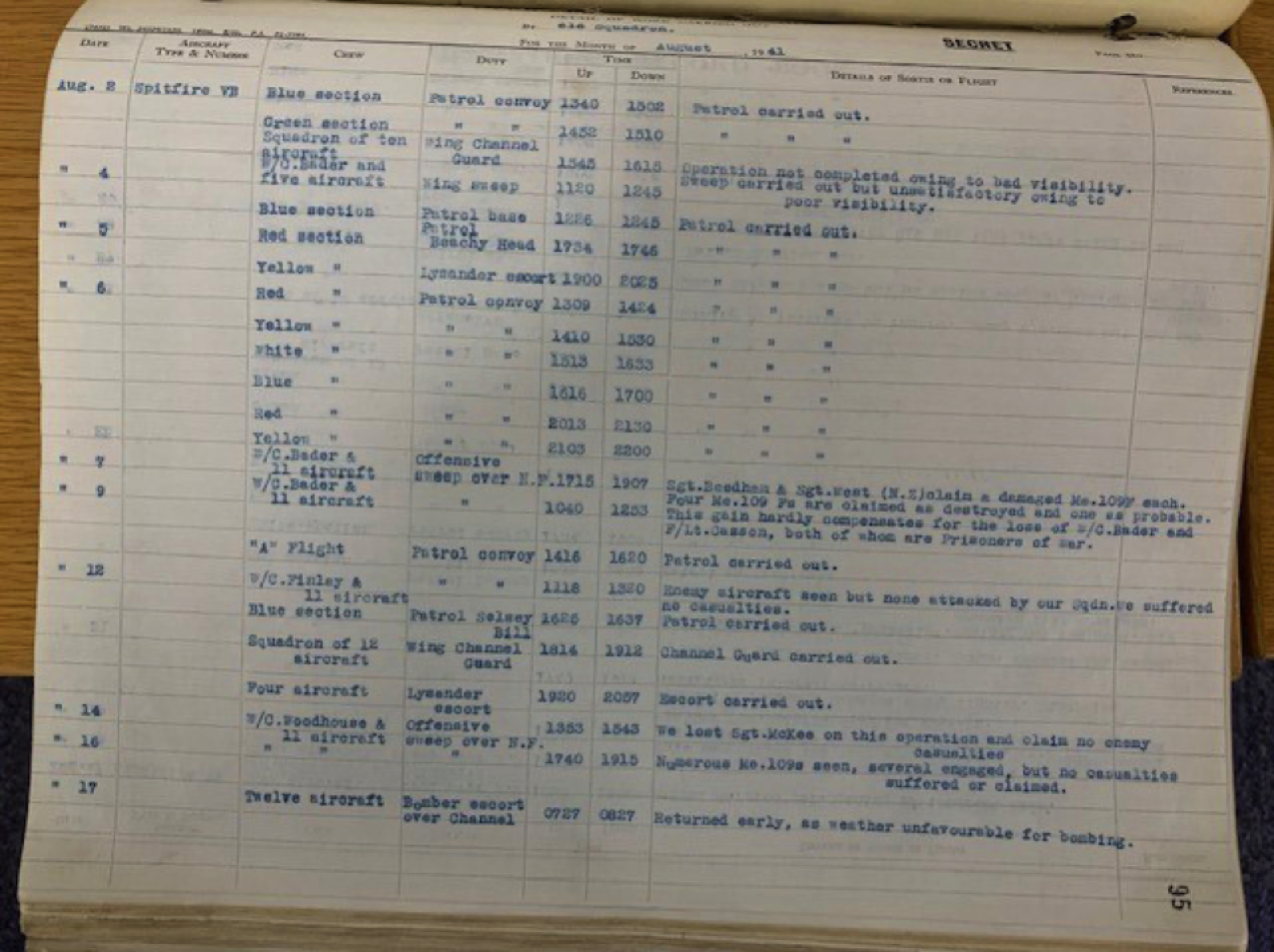
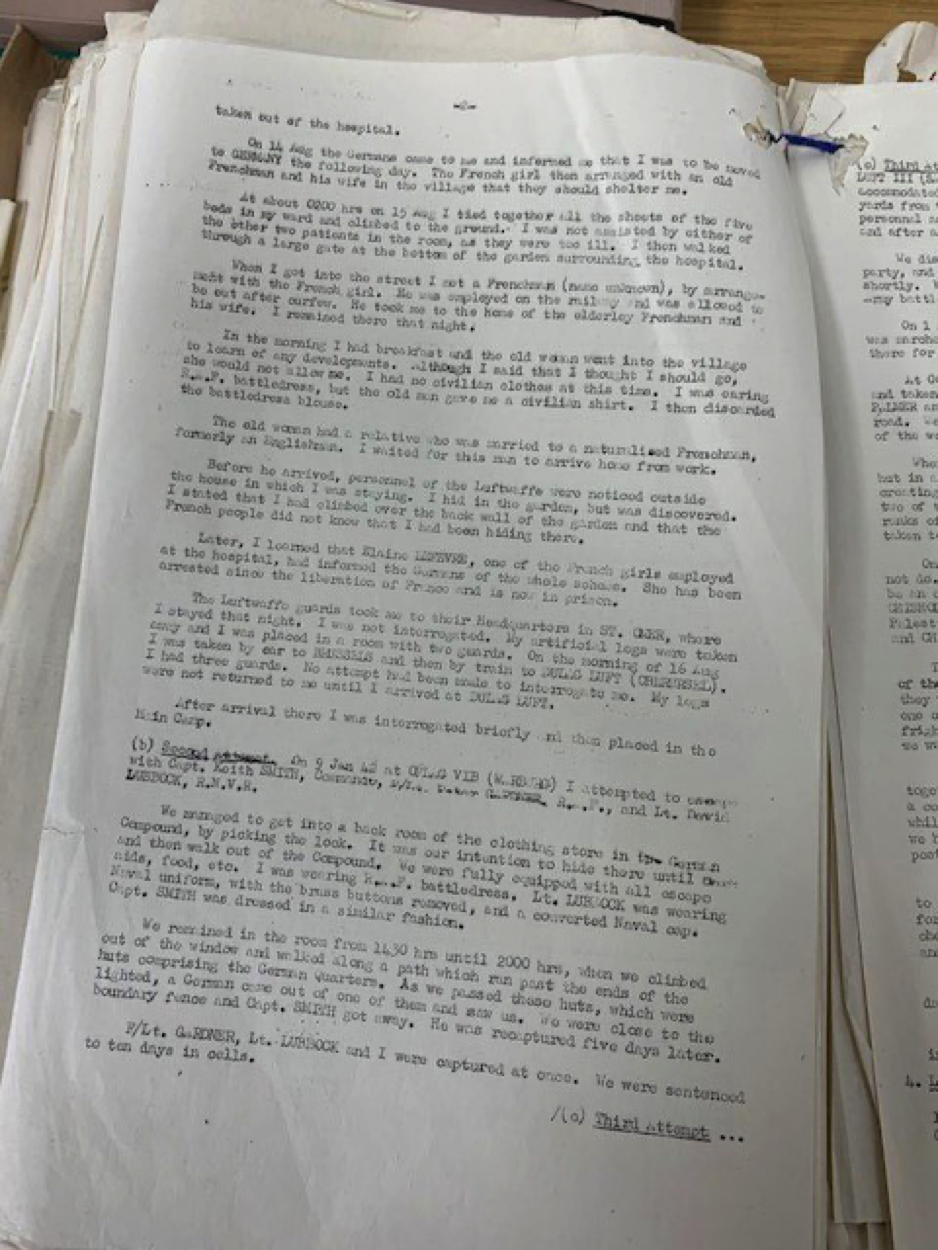
Meanwhile, with the permission of Reichsmarschall Goering, the Luftwaffe radioed England for a new leg providing unrestricted access over St Omer. It was sent in a Blenheim on a normal bombing raid on the night of 19 August 1941. At 15,000 feet, just south of St Omer, the leg was dispatched with stump socks, powder, tobacco and chocolate.
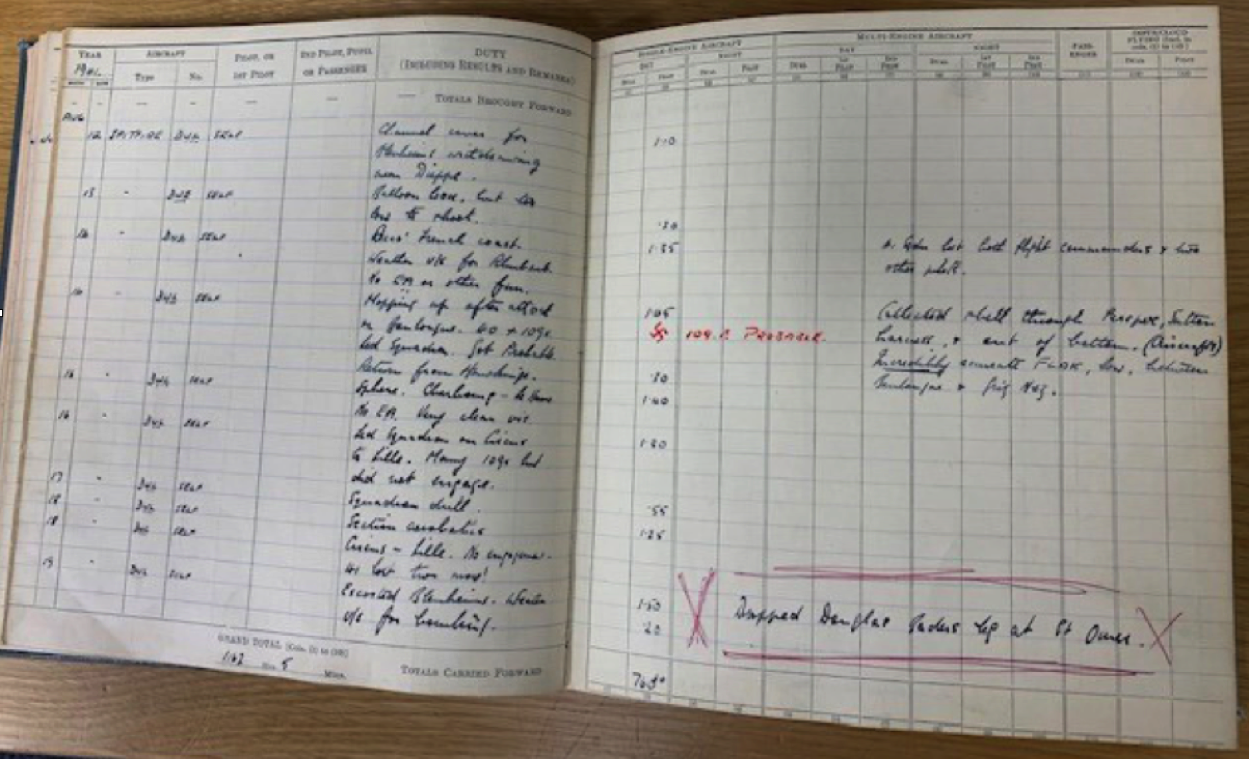
Entry on mission to drop the replacement artificial leg for Douglas Bader over St Omer on 19 August 1941.
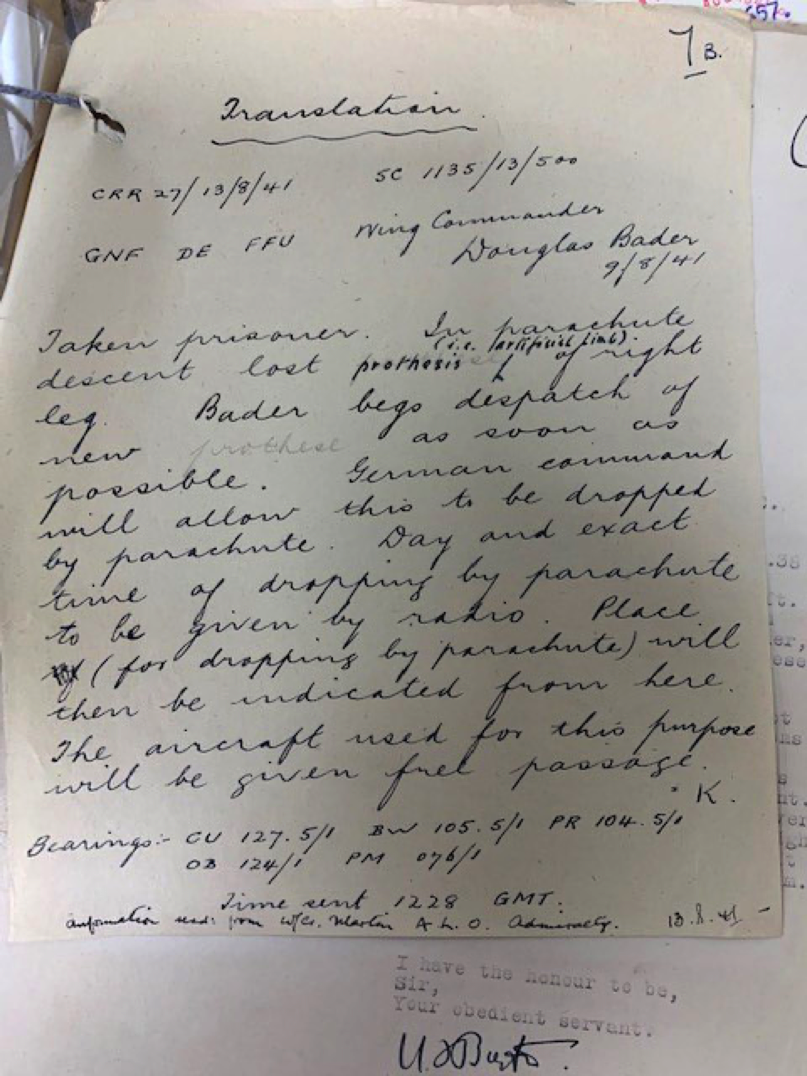
Reunited with his artificial legs, and unable to get on with his captors, Bader was transferred to the officers’ camp Oflag VIB in Lubeck and later to Stalag Luft III in Sagan. It was here he met Group Captain Harry Day and Royal Navy Fleet Air Arm pilot Jimmy Buckley. Day would go on to be part of the famous Great Escape from Stalag III in February 1943.
Bader joined the Escape Committees in the various camps he was sent to, but his roles in escape attempts were often restricted to ‘goon-baiting’, where he attracted the attention of his captors away from any escape operation. For example, when German squads strode past singing marching songs he organised men to whistle opposition tunes and put them out of step.
Bader, himself so desperate to escape, was disappointed as the Escape Committees had serious doubts about his success, though two ultimately unsuccessful attempts were made at Oflag VIB and Stalag VIIIB in Lamsdorf. Eventually, Bader was transferred to Oflag IVC at Colditz where he remained until the end of the war, when the camp was liberated by US forces in April 1945.
Upon liberation, like all allied prisoners of war he was encouraged to complete a liberation questionnaire.
As well as giving personal details, name, rank, number, unit and home address, these records can include: date and place of capture; main camps and hospitals in which imprisoned and work camps; serious illnesses suffered while a prisoner and medical treatment received; interrogation after capture; escape attempts; sabotage; suspicion of collaboration by other Allied prisoners; details of bad treatment by the enemy to themselves or others.
Three German soldiers found him and carried him to the nearest hospital in St Omer, close to where his father was buried 20 years previously. Bader requested that the Germans radio England and ask them to send over a second leg. Although his missing right leg was found, it was badly smashed but repaired sufficiently to wear. So much so that it was at this point that Bader made the first of three escape attempts on 15 August, though he was caught within 24 hours by the Luftwaffe and transferred to Dulag Luft in Oberursel, an allied aircrew reception centre, where prisoners were interrogated before being dispatched to Stalag Luft camps.
Bader’s account of his attempted escapes from the hospital at St Omer on 15 August 1941.
A translation of the German order to permit the dispatch of a prosthetic leg, heralded as Operation Leg.
Operational record book for 616 Squadron, reporting the loss of Wing Commander Bader and his aircraft on 9 August 1941.
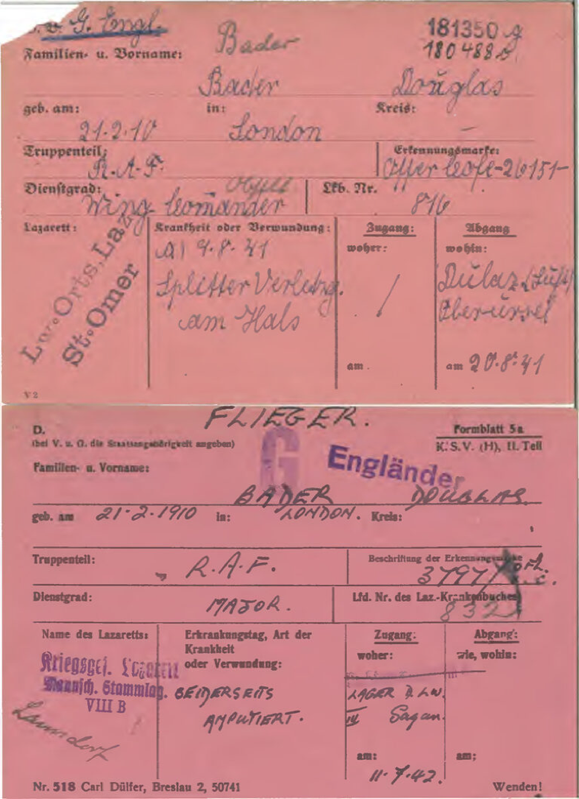
Bader’s prisoner of war card that would accompany him as and when he would transfer to other camps.
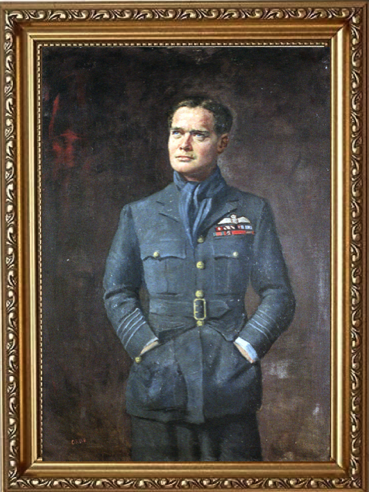
Douglas Bader - Roger Kershaw National Archives
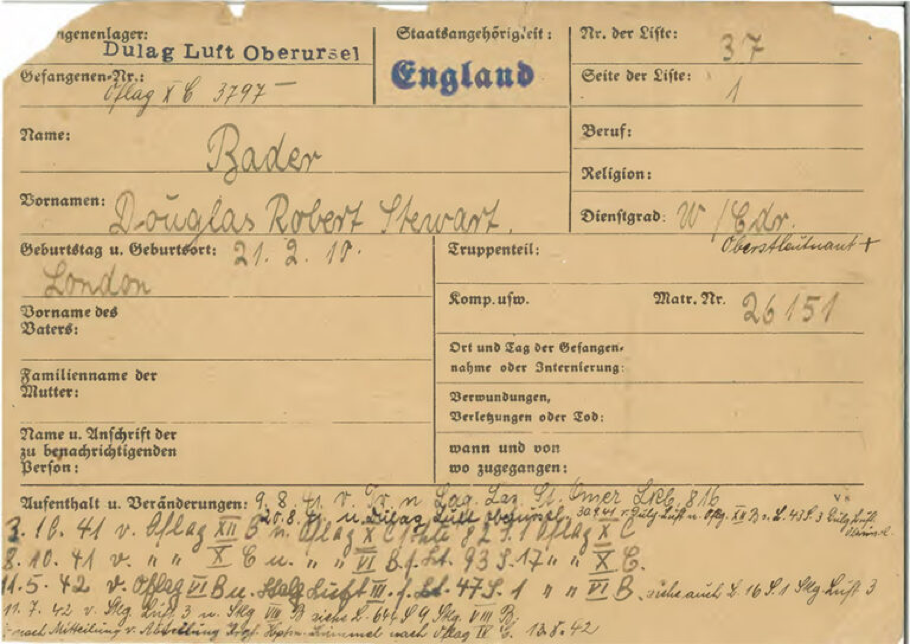
Hospital medical cards referring to the fact that Bader is an amputee.
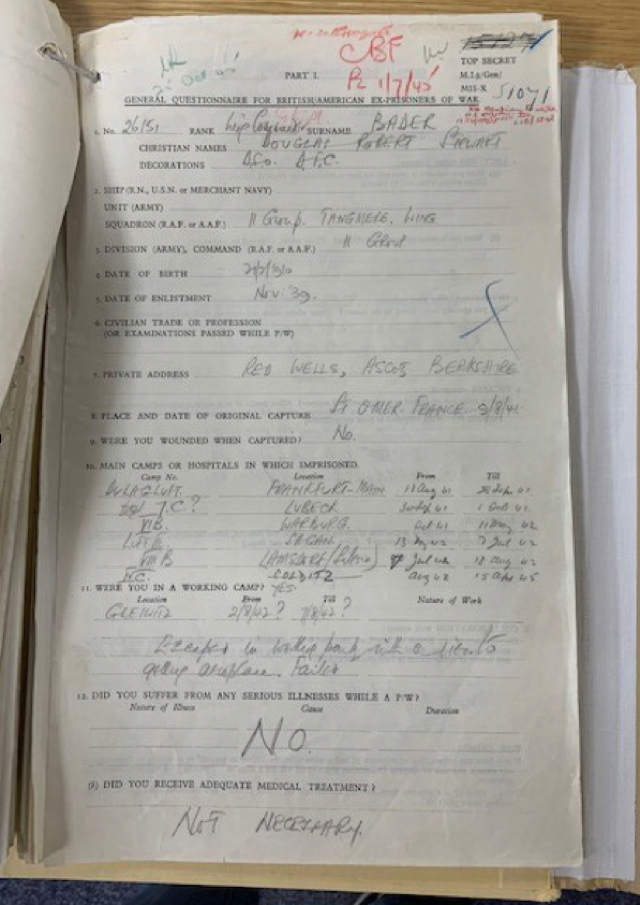
Bader died of a heart attack aged 72 on 5 September 1982, just two months after the film actor Kenneth More, who portrayed him in the 1956 British film Reach for the Sky, based on Bader’s biography of the same name published two years earlier. He will be remembered for a multitude of reasons but it was for his services with disabled people, setting an example of how to overcome a disability, that he was knighted in 1976.
Bader’s liberation questionnaire completed on 18 April 1945.
Article published by Roger Kershaw, National Archives

